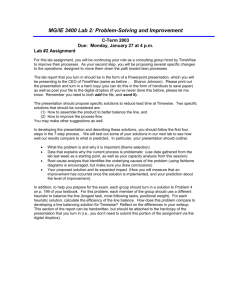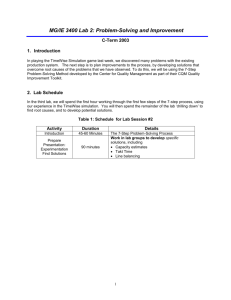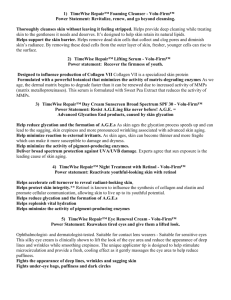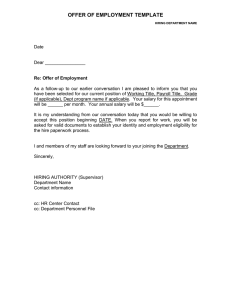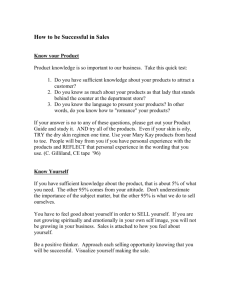JOBS INDEX THE TIMEWISE
advertisement
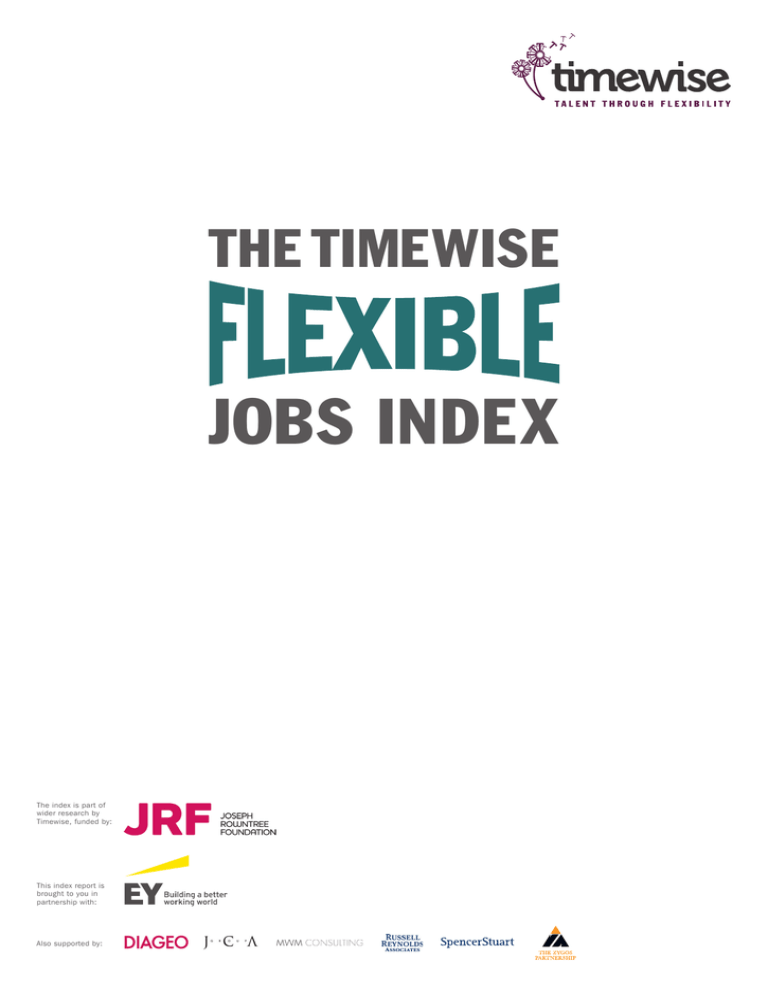
THE TIMEWISE JOBS INDEX The index is part of wider research by Timewise, funded by: This index report is brought to you in partnership with: Also supported by: THE TIMEWISE FLEXIBLE JOBS INDEX IT’S TIME FOR INNOVATION ON FLEXIBLE HIRING Welcome to the first ever nationwide research into the flexible recruitment market. INNOVATION To avoid any confusion, this is about quality jobs – not poorly paid zero hours contracts, low-skilled roles or seasonal labour. It’s also not about people working flexibly in their current roles, the benefits of which are well documented elsewhere. while an additional 629,000 people (mainly women)4 want to work, but can’t find a job with the flexibility to fit with their caring responsibilities. All of these people need a flexible jobs market they can go to. This research is about overtly offering candidates options to work flexibly at the point when you hire them, into roles paying £20,0001 or more. And that’s something that is relatively rare, barely understood, and is causing a ‘talent bottleneck’. The problem is that an employer doesn’t wake up in the morning thinking ‘I want to hire someone on a flexible basis.’ But when we ask employers this question: ‘Would you like to see a brilliant candidate who wants to work flexibly?’… the answer is frequently ‘Yes, show me the candidate.’ The nub of the problem is that flexible hiring is out of step with flexible working, which is now widely practised by many businesses. We know that employers consistently underestimate just how precious a benefit flexibility is – so they rarely think to mention it in job ads alongside other benefits such as a competitive salary, pension, or health insurance. Flexible hiring is relatively rare, barely understood, and is causing a talent bottleneck. Change in the recruitment market is long overdue. Karen Mattison, joint CEO, Timewise 02 | Timewise Flexible Jobs Index | 2015 But how do candidates wanting flexibility know they can apply, if the job ad doesn’t say so? 52% of people seeking a flexible job feel nervous to ask for flexibility when the word isn’t used in the advert; 43% fear it will damage their chances of getting the job2. Jobs advertised with flexibility are so scarce that 77% of flexible workers feel ‘trapped’ in their current role2. All too often their career progression grinds to a halt as their skills become under-utilised. They get stuck at one level and many end up leaving their profession in frustration. So, this new index of flexible job vacancies is intended to shine a light on these problems. We hope it will help businesses to realise that flexible working has limited impact if it does not extend to the hiring process. And we hope that employers will begin to advertise more of their jobs as ‘open to flexible working options’, enabling them to access the very best possible talent. And the flexible talent pool is massive: more than 5.4 million people already work in flexible roles3, Karen Mattison and Emma Stewart Joint CEOs of Timewise www.timewise.co.uk | 03 OBJECTIVES, METHODOLOGY AND DEFINITIONS FILL THE Objectives of the index •To help fill a knowledge gap by providing the first ever national index of quality flexible job vacancies •to track progress in flexible hiring by updating the index annually •to enable employers to measure how well their recruitment practice keeps pace with the index, or betters it. Methodology GAP The Timewise Flexible Jobs Index is based on data from over 3.5m job ads on 122 UK job boards, in the period July to December 2014. The job ads were filtered using 70 keywords relating to different forms of part time and flexible working. The database is held by Innovantage and was aggregated by Talent Cube. WHAT DO WE MEAN BY A ‘QUALITY FLEXIBLE JOB’? Different organisations use different language for ‘flexible working’ – agile working or smart working for example. But we’re all talking about the same thing: working patterns that are different from a rigid 9 to 5 at the employer’s premises. Flexible By ‘flexible’ we mean any job that is either advertised as part time or, if full time, is advertised offering at least one of these forms of flexibility: • the possibility of a reduced hours contract •a different pattern of work such as flexitime or shifts (provided the arrangement is intended to offer choice and a better work-life balance, rather than being restrictive or necessitating unsociable hours) •the ability to work from home for some or all of the working week •open to discussion about flexibility on either hours or location. Quality By ‘quality’ we mean: T he Office for National Statistics gathers employment data about people working part time, and also those working from home. But ONS data on job vacancies does not analyse the split between part time and full time hiring. There’s a clear gap in market knowledge. •jobs with an annual FTE salary of £20,000 or higher1 •excluding jobs that are: low paid zero hours, temping, self-employed, freelance, franchise opportunities. John Philpott, Director, The Jobs Economist 04 | Timewise Flexible Jobs Index | 2015 www.timewise.co.uk | 05 THE SQUEEZE BETWEEN FLEXIBLE WORKING AND FLEXIBLE HIRING This first Timewise Index shows that jobs advertised with flexible options account for only 6.2%5 of all jobs with a salary over £20,000 (FTE). The demand for these flexible jobs far outweighs the supply. Nobody keeps data by salary band, but across all salary levels, the numbers of employees who want flexible work is huge: 5.4 MILLION3 Work part time already, through choice 8.7 MILLION6 Are working full time, don’t have flexibility, and claim they want it 14.1 MILLION TOTAL WHO WANT FLEXIBLE WORKING =46% Proportion of people in employment in the UK, who want flexible working 7 TIMEWISE VIEW • E mployers are cutting themselves off from a proportion of the candidate market, by not stating their openness to flexibility in their recruitment advertising. These ‘lost’ candidates include some of the very best available talent. •Employers can begin to alleviate the talent crisis, and improve diversity at senior levels, by offering flexibility at the point of recruitment. •There is a message for Government too: although ONS keeps statistics on the number of people working part time, there is no one single source for data on the number of people working flexibly (whether contractually or informally). There is a need for clearer information around the practice of flexible working, which is changing rapidly in the modern workplace. ONS records people in part time work who ‘would prefer to work full time’ and who ‘do not want a full time job’, but not people in full time work who would ‘prefer to work part time’. The impact on career progression The Index shows that while companies have embraced flexible working for existing employees, their approach does not extend to making new hires. This seems inconsistent. If businesses could offer flexibility for new hires too, we might just see a much wider pool of female talent open up - benefiting businesses by alleviating the stubborn problem of too few women in the talent pipeline. The lack of jobs advertised with flexibility is causing a bottleneck for hundreds of thousands of flexible workers. Without a flexible job market to go to, many stay too long in their current role – caught on the ‘sticky floor’ that keeps many employees (particularly women) in the middle of the career ladder. Worse still, 41% of flexible workers2 say they have actually ‘traded down’, taking a job below their skill or salary level in order to get the flexibility they need. There is a clear loss to business through under-utilisation of skills. 6.2% of job ads offer flexible working options Helena Morrissey CBE, CEO of Newton Investment Management and Founder of the 30% Club A6 | Timewise Flexible Job 06 JobsIndex Index || 2015 2015 www.timewise.co.uk | 07 TWO ROLE CATEGORIES LEAD THE WAY IN FLEXIBLE HIRING The proportion of jobs advertised with flexible options varies considerably depending on the type of role. Health and social care jobs, and also education jobs, are significantly ahead of all other categories. It’s important to note that these are role types, not industry sectors. For health and social care, the figures reflect the common practice of employing nurses, care workers and clinical staff in flexible shift patterns. In the education sector, the figures reflect the use of supply teachers and also part time arrangements for teaching assistants and those working in adult education. LEADING ROLES I’m glad that I’ve chosen a role where I can progress my career whilst working flexibly, because I know that one day it will help with having a family. I have friends who are working as solicitors and in other roles, who are really envious of that. Lana Northey, Commissioning Officer, Adult Social Care, Leeds City Council 08 | Timewise Flexible Jobs Index | 2015 TIMEWISE VIEW •Health and education are particularly ‘feminised’ role categories and this may have led the more widespread practice of flexible hiring here. Certainly, businesses wanting to attract women will benefit by advertising flexible options. •Employers could use flexible hiring to competitive advantage, to attract talent into roles where they have particular problems with skills shortages. The differences between the role categories are extreme: the proportion of health and social care jobs advertised with flexible options is ten times greater than it is for roles in engineering, marketing, senior management or IT. This is perhaps surprising, as some of these job categories suffer from acute skills shortage problems, which could potentially be addressed by accessing the wider talent pool that is available to work flexibly. It is also interesting to see low rates of retail and catering jobs being advertised with flexibility at salaries above £20k FTE, as these categories are known to employ large numbers of part time and flexible roles at lower salaries. There is clearly a lack of progression for those in these roles who want to climb higher up the pay-scale but need to retain their flexible working pattern. Proportion of jobs advertised with flexibility, by role type... Health / Social Care 20% Accounting / Finance 3% Education / Training 13% Arts / Media / Design 3% Military / Policing / Security 7% Catering / Hospitality 3% Banking / Insurance 3% Admin / Secretarial / PA 6% Science / Technology 3% HR 5% Consultant / Analyst 3% Retail 5% Customer Service 5% Supply Chain / Logistics 4% Sales 4% Legal 3% IT 2% Director / Management 2% Marketing / Advert / PR 2% Engineering / Manufacturing 2% www.timewise.co.uk | 09 FLEXIBILITY DECLINES AT HIGHER SALARY LEVELS I used to be a Group Account Director at a large marketing agency, but after taking a career break I found that flexible vacancies at my level just didn’t exist. It was a hard choice to make, but I’ve opted out of having a senior level career. Flexibility is a deal-breaker for me. Elizabeth Doughty, now a copywriter Analysis by salary band reveals that job opportunities for flexible working decline as the salary rises. A candidate looking for flexible work below £30k FTE will find around twice the job opportunities (as a proportion of all jobs at that level), compared to a candidate looking for work at over £40k FTE. pipeline to the top of business; yet the lack of flexible opportunities in both internal and external recruitment is cutting many of these employees off from career progression. The ‘sticky floor’ is one of the main reasons why it’s difficult to hire women at senior levels. Senior professionals and managers are the people that employers need to encourage most, in order to maintain a fluid talent Relative proportion of jobs advertised with flexibility, by salary: 6% £20,000-£29,999 5% £30,000-£39,999 £40,000-£49,999 3% £50,000-£99,999 3% £100,000-£199,999 2% TIMEWISE VIEW •At salaries between £20k and £40k, the poor supply of jobs advertised with flexibility presents a huge challenge for candidates who can’t work full time. And of course, these salary bands represent a high proportion of the working population. •At salaries above £40k, candidates feel the squeeze even more. Businesses wanting to accelerate the female talent pipeline need to match flexible hiring (including flexible promotion) to the availability of flexible working at these mid-management levels. 10 | Timewise Flexible Jobs Index | 2015 www.timewise.co.uk | 11 FLEXIBLE OPPORTUNITIES ARE BETTER OUTSIDE THE CAPITAL Unlocking the potential of talented individuals who wish to work flexibly is a source of competitive advantage. I have seen first-hand how it can help attract and retain the best and brightest talent and lead to higher levels of client service. Steve Varley, Chairman and Managing Partner, UK&I, EY LONDON LEAST 12 | Timewise Flexible Jobs Index | 2015 Candidates looking for flexible jobs have comparatively greater opportunities in Scotland, Northern Ireland and in the north east of England. London fares the worst, reflecting a regional bias that can also be seen in ONS data on the part time employment market8. It may be that employers in London haven’t felt the need to adapt to demand for flexible jobs, because of the plentiful supply of candidates. However, the argument for flexible hiring is more a case of quality than quantity – some of the very best candidates will only consider flexible roles, and employers are currently missing out on their hard earned skills and experience. Relative proportion of jobs advertised with flexibility, by region 7% 6% 5% 4% 3% TIMEWISE VIEW •Bigger businesses find it particularly difficult to see the need for flexible hiring, especially in London with its huge workforce. However, the ‘default’ practice of advertising jobs on a full time basis is cutting employers off from some of the best available talent. •It’s important not to let the London bias distract from low rates of flexible hiring elsewhere. Talent acquisition is a concern for all employers, and in all regions there is a low rate of flexible recruitment. The candidate demand for flexible working will be just as strong outside London, so employers are missing out here too. •There’s also a wider implication for the UK economy. Increasing flexible hiring will bring beneficial effects for industry as a whole, by reducing the skills drain of women who abandon their careers or trade down. Considerable time and money has been invested in training these employees, and maximising their productivity is critical. www.timewise.co.uk | 13 SUMMARY At Diageo, flexible working is part of who we are and how we operate - based on trust and results. Flexible working has allowed us to retain and develop some fantastic talent within the business, and we are opening up to flexible hiring as a natural step. Andrew Porter, Head of Talent Engagement, Europe, Diageo Conclusions •The Timewise Flexible Jobs Index has identified a large gap between flexible working (which is now widely accessible to employees) and flexible hiring (which is relatively rare). •The scarcity of jobs advertised as being open to flexible options is at its worst in professional office roles, at higher salaries and in London. Implications for employers OPEN UP 14 | Timewise Flexible Jobs Index | 2015 •The gap between flexible working and flexible hiring is causing a talent bottleneck. Without a flexible jobs market they can go to, employees are getting ‘stuck’ in their current flexible jobs, or even choosing to trade down to get the flexibility they need. Businesses are losing out through the under-utilisation of skills, and even the complete loss of valuable employees. •By not saying they’re open to flexibility in recruitment advertising, employers are cutting themselves off from a proportion of the candidate market, which includes some of the very best available talent. •Businesses wanting to improve diversity in senior management need to adapt to flexible hiring at recruitment, and in internal resourcing too. The lack of job mobility and career progression for flexible workers is a major factor in the failure of the female talent pipeline. Employers should be mindful not only of their glass ceilings, but their sticky floors. Recommendation •The good news is that adapting to flexible hiring is easy. Employers simply have to ask themselves: “For the best candidate, will I consider flexible working for this role?” Then, if the answer is ‘yes’, say so in their recruitment advertising. This doesn’t commit an employer to making the role flexible, it just means being open to discussion for the right candidate. 1 or the purpose of further JRF research commissioned through Timewise, a threshold of £19,500 is being used to define a quality job in terms of the minimum salary F needed for people to live on. For this index of the jobs market, the proxy threshold of £20,000 is used in order to align with the way the recruitment industry uses salary bands. Less than 1% of analysed jobs had salaries between £19,500 and £19,999, and their omission has no impact on the overall percentage of flexible jobs (6.2%). Jobs at salaries of £200,000 or more are excluded from the analysis, as the majority of these jobs contained typing errors that meant they were incorrectly categorised. 2 Source: ‘The Flexibility Trap – a report on how flexible working helps career progression’, the Timewise Foundation, 2013. 3 ource: ONS Labour Force Survey, Jan-Dec 2014 average – 5.4m work part time and ‘do not want a full time job’; this does not include full S time employees who work flexibly in some way (eg work from home). 4 Source: ONS Labour Force Survey, 2014, analysis by CESI. 5 ote on the data: an adjustment was made to the raw data to allow for flexible keywords found in longer text from job ads than is stored on the source database. A N representative sample of longer text job ads was analysed manually and the proportion of flexible jobs was then adjusted from 4.5% to 6.2%, with an error margin of 2% at 95% certainty, meaning that the true % of flexible jobs is in the range 4.5% to 8.2%. In the analysis by role type / salary band / region, the raw percentages have not been adjusted, as it was not possible to sample sufficient job ads to reach statistically reliable adjustments across the smaller sub-sets. 6 Source: ‘A Flexible Future for Britain?’ - report by Timewise, 2014. 7 Source: ONS, Labour Market Statistics releases, 2014 – average total number in employment in UK is 30.7m, of which 14.1m = 46% 8 ource: ONS Regional Labour Statistics, April 2015, 23% of employees in London work part time, the lowest proportion of any UK region S (average proportion for the UK as a whole is 27%). www.timewise.co.uk | 15 Timewise helps businesses to attract and develop the best talent through flexible working. We share market insights, deliver training and consultancy, and provide recruitment services. Contact us on 0207 633 4559 www.timewise.co.uk Research Partners:
